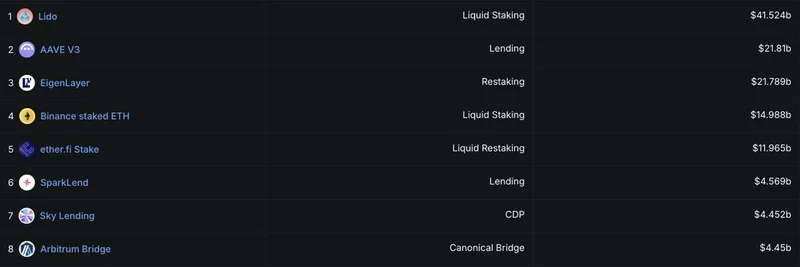In the ever-evolving world of decentralized finance (DeFi), keeping track of where all that ETH is going can give us some serious insights into the hottest trends. Recently, DeFi Llama, a go-to analytics platform for all things DeFi, dropped a fascinating update on Twitter highlighting the top protocols gobbling up billions in ETH deposits. According to their data, there are now 10 protocols each holding over $3 billion in ETH, with five of them surpassing the $10 billion mark. That's a massive chunk of the Ethereum ecosystem locked up in staking, lending, and more.
Let's break this down. The chart shared by DeFi Llama shows the top contenders, categorized by their primary functions like liquid staking, lending, restaking, and bridges. At the top of the list is Lido, a liquid staking powerhouse with a whopping $41.524 billion in ETH. Liquid staking, for those new to the term, lets you stake your ETH to secure the network while still using a liquid token (like stETH) in other DeFi activities—basically, having your cake and eating it too.
Right behind is AAVE V3, a leading lending protocol with $21.81 billion. AAVE allows users to borrow and lend crypto assets in a decentralized way, often used by traders to leverage positions or earn yields on idle assets. Then there's EigenLayer at $21.789 billion, pioneering restaking. Restaking builds on liquid staking by allowing those staked assets to secure other networks, potentially boosting yields but with added risks.
Other notable mentions include Binance Staked ETH ($14.988 billion, another liquid staking option), Ether.fi Stake ($11.965 billion, liquid restaking), SparkLend ($4.569 billion, lending), Sky Lending ($4.452 billion, a collateralized debt position or CDP platform), Arbitrum Bridge ($4.45 billion, a canonical bridge for layer-2 scaling), Base Bridge ($3.802 billion, another bridge), and Rocket Pool ($3.314 billion, liquid staking).
This surge in ETH deposits underscores the growing popularity of yield-generating strategies in DeFi. For meme token enthusiasts, this is particularly relevant because many meme projects on Ethereum rely on these protocols for liquidity and trading. High ETH locks in lending platforms like AAVE can mean more borrowing power for speculative trades, while staking solutions keep the network secure and liquid for fast meme launches and pumps.
What's driving this? Ethereum's shift to proof-of-stake has made staking more accessible, and innovations like restaking are opening new avenues for returns. However, it's worth noting the concentration risks—if a major protocol like Lido faces issues, it could ripple through the ecosystem.
If you're diving into meme tokens or broader DeFi, tools like DeFi Llama are invaluable for staying informed. Keep an eye on these protocols; they might just hint at the next big trend in blockchain tech. What do you think—will we see even more protocols hitting these milestones soon?


